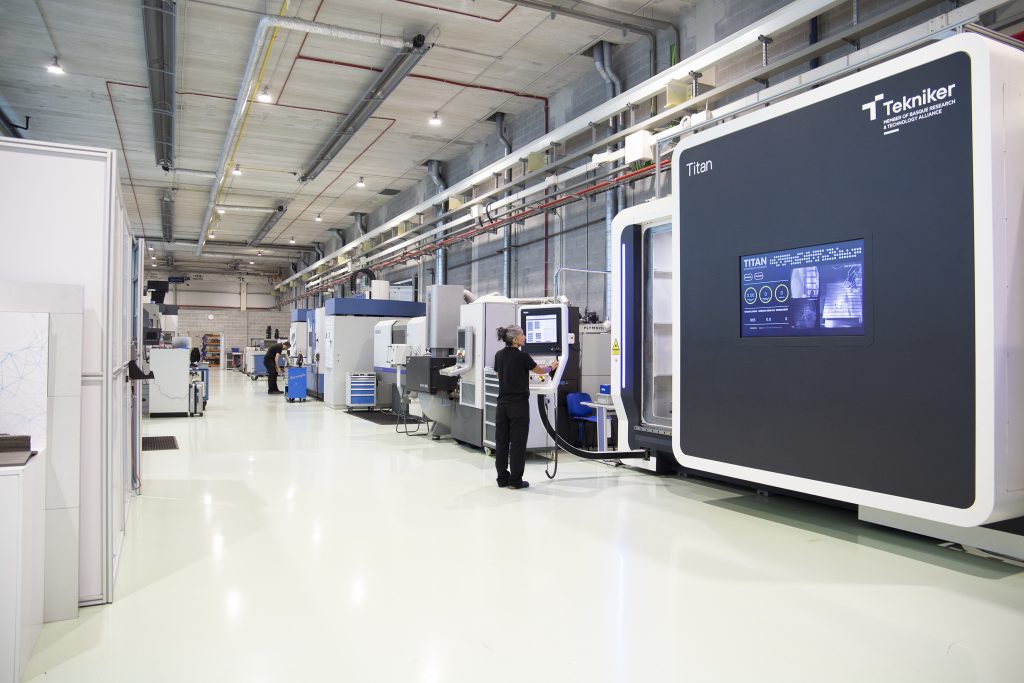The Tekniker Technology Centre, a Basque Research and Technology Alliance (BRTA) member, is exhibiting its latest developments in advanced manufacturing, surface engineering, and information and communication technologies (ICTs) for production.
Scheduled from June 3rd to 7th, this showcase will take place at the upcoming International Machine Tool Biennial Exhibition (BIEMH) 2024. The key highlight includes the TITAN machine, a large-scale 3D printer measuring 6100 mm x 3100 mm x 3420 mm. This machine uses Direct Energy Deposition (DED) technology to manufacture complex geometric metallic structures. The DED process utilizes laser technology to deposit metal wire onto the build platform directly.
Carlos Soriano, a Tekniker researcher, said, “TITAN is a piece of innovative advanced manufacturing equipment fully developed by Tekniker to produce large parts that incorporate a range of metal alloys to withstand extreme operating conditions. Consequently, we will showcase a rocket engine nozzle currently being manufacturing on a machine that simulates environmental conditions on planet Mars.”

Demonstrations in robotics, materials, and applications
Tekniker explains that the TITAN machine features a controlled atmosphere enclosure, allowing it to simulate various environmental conditions. This functionality is particularly advantageous for industries like aerospace, and shipbuilding, among others, where components must endure extreme climates. During the exhibition, Tekniker intends to demonstrate the capabilities of the TITAN by showcasing components such as propellers and spheres produced through this system.
Alongside TITAN, Tekniker is also unveiling a collaborative robotic cell at the exhibition, demonstrating its ability to perform a “bin picking” process. Here, a robot adeptly retrieves parts from a disorganized lateral loading tray, arranging them systematically near the exit. This demonstration incorporates Tekniker’s technologies, such as the SmartPicking software, which employs 3D vision to precisely guide the robot in picking the correct parts.
Additionally, the “Proximity detector” software ensures the safety of human-robot interactions by maintaining a secure distance from operators. Augmented reality goggles, like HoloLens, provide a simulated environment for monitoring the robot’s movements, while digital twin technology enables a direct comparison between the physical robot and its virtual counterpart on the device.
Moreover, Tekniker will be demonstrating its capabilities in surface treatment and material selection for parts manufactured using DED technology. Attendees can expect to see a variety of surface finishing techniques and gain insights into developing innovative tribological materials. These materials offer a unique combination of exceptional wear resistance, mechanical strength, and high energy density.
Developments in DED systems and applications
The list of companies offering DED 3D printers continues to grow, with Tekniker adding its unique contribution. For instance, Japanese multinational Nikon launched the Lasermeister LM300A DED 3D printer and Lasermeister SB100 3D scanner for industrial applications, focusing on repairing metal parts such as turbine blades with high precision.
The SB100 scans components and generates tool paths for the LM300A, promising significant reductions in lead times and post-processing. Leveraging advanced optical and precision controls, the LM300A achieves precise results with materials like Nickel alloys and Titanium. Sales commence in spring 2024, targeting sectors including aerospace, automotive, railways, and machinery, offering streamlined repair solutions through automated processes.
Back in 2022, engineers at the Indian Institute of Technology (IIT), Jodhpur, developed a low-cost metal AM system based on DED technology. Except for the laser and KUKA robotic arm, this system was entirely designed and manufactured in India.
With this system, the team sought to make metal AM more affordable in the country, intending to expand its usage across aerospace, defense, and other engineering sectors. The system specializes in laser cladding and maintenance applications, enhancing existing metal components by adding material. It features India’s first variable spot size laser optics and integrated in-situ monitoring for precise control during industrial use.
What 3D printing trends do the industry leaders anticipate this year?
What does the Future of 3D printing hold for the next 10 years?
To stay up to date with the latest 3D printing news, don’t forget to subscribe to the 3D Printing Industry newsletter or follow us on Twitter, or like our page on Facebook.
While you’re here, why not subscribe to our Youtube channel? Featuring discussion, debriefs, video shorts, and webinar replays.
Featured image shows the TITAN 3D printer inside the technology centre. Photo via Tekniker Technology Centre.



